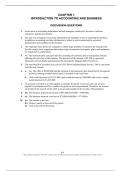Exam (elaborations)
Solution Manual For Accounting 28th Edition by Carl S. Warren, Christine Jonick| All Verified Chapter's (1 - 26) | Newest Version 2024 A+
- Course
- Institution
- Book
Solution Manual For Accounting 28th Edition by Carl S. Warren, Christine Jonick| All Verified Chapter's (1 - 26) | Newest Version 2024 A+ ing information include managers, employees, investors, creditors, customers, and the government. 2. The role of accounting is to provide information for man...
[Show more]



